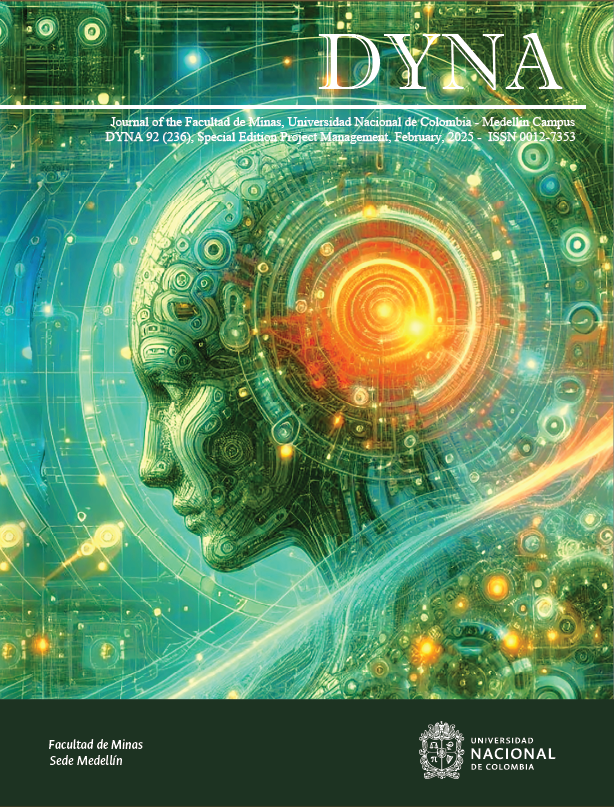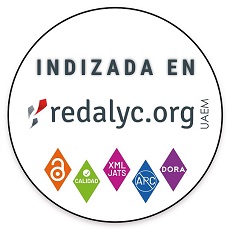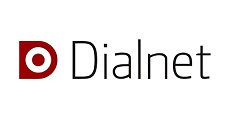From strategic planning to agility: strategic management approaches
Desde la planeación estratégica a la agilidad: enfoques de gestión estratégica
DOI:
https://doi.org/10.15446/dyna.v92n236.116945Palabras clave:
project management, strategic planning, strategic agility (en)gestión de proyectos, planificación estratégica, agilidad estratégica (es)
Descargas
Strategic management is fundamental to business development, but traditional strategic planning has lost its value due to uncertainty and constant market changes. Therefore, a new strategic paradigm known as agility has emerged, which promises to generate adaptation and sustainability for companies. The overall objective of this document is to examine strategic planning and organizational agility approaches, in order to understand how these paradigms can contribute to business advancement in dynamic and changing environments. A systematic review of the literature in scientific databases was carried out to achieve this. Expected outcomes include identifying differences between traditional strategic planning and organizational agility, understanding how agility can generate business adaptation and sustainability, and its implications in competitive environments. In conclusion, agility is essential for adaptation and sustainability, promoting dynamic strategies and skills such as problem solving and collaboration, improving business performance.
La gestión estratégica es fundamental para el desarrollo empresarial, pero la planificación estratégica tradicional ha perdido su valor debido a la incertidumbre y a los constantes cambios del mercado. Por ello, ha surgido un nuevo paradigma estratégico conocido como agilidad, que promete generar adaptación y sostenibilidad para las empresas. El objetivo general de este documento es examinar los enfoques de planificación estratégica y agilidad organizativa, con el fin de comprender cómo estos paradigmas pueden contribuir al avance empresarial en entornos dinámicos y cambiantes. Para ello, se ha llevado a cabo una revisión sistemática de la literatura en bases de datos científicas. Los resultados esperados incluyen la identificación de las diferencias entre la planificación estratégica tradicional y la agilidad organizativa, la comprensión de cómo la agilidad puede generar adaptación y sostenibilidad empresarial, y sus implicaciones en entornos competitivos. En conclusión, la agilidad es esencial para la adaptación y la sostenibilidad, promoviendo estrategias dinámicas y habilidades como resolución de problemas y colaboración, mejorando el rendimiento empresarial.
Referencias
[1] Kearney, C., Strategic planning for financing and growing biotechnology companies: strategic planning for financing and growing biotechnology companies, Journal of Commercial Biotechnology, 24(4), pp. 62-66, 2019. DOI: https://doi.org/10.5912/jcb917
[2] Nugraha, D., Reftyawati, D., and Sari, Y.A., The effective school strategic plan implementation: a best practice of school improvement, Attractive: Innovative Education Journal, 2(2), pp. 9-19, 2020.
[3] Francis, D., The agile paradigm and organisation development in higher educational institutions, in: 8th International Conference on Higher Education Advances (HEAd’22), Universitat Politecnica de Valencia, Spain, 2022, pp. 833-840. DOI: https://doi.org/10.4995/HEAd22.2022.14658
[4] Teece, D., Peteraf, M., and Leih, S., Dynamic capabilities and organizational agility: risk, uncertainty, and strategy in the innovation economy, California Management Review, 58(4), pp. 13-35, 2016. DOI: https://doi.org/10.1525/cmr.2016.58.4.13
[5] Walter, A.-T., Organizational agility: ill-defined and somewhat confusing? A systematic literature review and conceptualization, Management Review Quarterly, 71, pp. 343-391, 2021. DOI: https://doi.org/10.1007/s11301-020-00186-6
[6] Roig-Vila, R., y Moreno-Isac, V., El pensamiento computacional en Educación. Análisis bibliométrico y temático, Revista de Educación a Distancia (RED), 20(63), pp. 1-24, 2020. DOI: https://doi.org/10.6018/red.402621
[7] Aponte, A.C., La necesidad de la planeación estratégica para la profesionalización de la pequeña y mediana empresa (pyme). Negonotas Docentes, (15), pp. 64-73, 2020. DOI: https://doi.org/10.52143/2346-1357.726.
[8] Machado, H.P.V., Cazella, C.F., Piekas, A.A.S., and Carvalho, C.E., Entrepreneurship and strategy: analyzing themes from bibliometric studies in the light of the concept of strategic entrepreneurship. Brazilian Administration Review, 18(3), e200036, 2021. DOI: https://doi.org/10.1590/1807-7692bar2021200036
[9] Reinholz, DL., Pilgrim, ME., Stone-Johnstone, A., Falkenberg, K., Geanious, C., Ngai, C., Corbo, J.C., and Wise, S., Focus on Outcomes: Fostering Systemic Departmental Improvements. To Improve the Academy: A Journal of Educational Development, 40(2), art. 154, 2021. DOI: https://doi.org/10.3998/tia.154
[10] Bütüner, H., and Senoglu, P., Development of an entrepreneurial business’ (Natural Food’s) strategic plan by shortened Systematic Strategic Planning (SSP) working model: case study. European Journal of Business and Management Research, 8(1), pp. 350–358, 2023. DOI: https://doi.org/10.24018/ejbmr.2023.8.1.1811
[11] Fuertes, G., Alfaro, M., Vargas, M., Gutierrez, S., Ternero, R., and Sabattin, J., Conceptual framework for the strategic management: a literature Review—Descriptive, Journal of Engineering, 2020, art. 6253013, 2020. DOI: https://doi.org/10.1155/2020/6253013
[12] Chandler, A., Strategy and structure. in history of the american industrial enterprise. Beard Books. 1962.
[13] Uriarte, A., and Obregon, I., La estrategia empresarial como método. Desclée de Brouwer Ed., 2019.
[14] Porter, M., Competitive advantage: creating and sustaining superior performance. Simon and Schuster, Free Press, NY, USA, 2008.
[15] Chiavenato, I., Comportamiento organizacional: la dinámica del éxito de las organizaciones, 2nd ed., McGraw Hill, 2009.
[16] Hansen, E., and Juslin, H., Strategy and strategic planning. In: Strategic marketing in the global forest industries. Ecampus Open Educational Resources. Oregon State University, 2023, pp. 65-118.
[17] Savkín, A., Comparison of strategic planning tools and frameworks. BSC Designer. [online]. 2020. Available at: https://bscdesigner.com/strategic-frameworks-comparison.htm.
[18] Porter, M.E., Competitive strategy, techniques for analyzing industries and competitors. The Free Press. New York, USA, 1980.
[19] Barasa, M., Organizational strategic planning, implementation and evaluation with analysis of challenges and benefits for profit and nonprofit organizations. International Journal of Applied Research, 5(6), pp. 27–32, 2019. DOI: https://doi.org/10.22271/allresearch.2019.v5.i6a.5870
[20] Barnawi, M.B.O., Organizational excellence models failure and success factors of organizational excellence and challenges mitigation, Open Journal of Business and Management, 10(6), pp. 2915-2938, 2022. DOI: https://doi.org/10.4236/ojbm.2022.106144
[21] Dove, R., Schindel, B., and Scrapper, C., Agile systems engineering process features collective culture, consciousness, and conscience at SSC pacific unmanned systems group, INCOSE International Symposium, 26(1), pp. 982–1001, 2016. DOI: https://doi.org/10.1002/j.2334-5837.2016.00206.x
[22] Kirkpatrick, S.A., Miller, S.C., Terragnoli, A., and Sprenger, A., Development of an organizational agility assessment for government and nonprofit organizations, Organization Development Journal, 39(2), pp. 67–82, 2021. DOI: https://doi.org/10.5465/AMBPP.2020.10088abstract
[23] Sutherland, J., The scrum fieldbook: a master class on accelerating performance, getting results, and defining the future, Currency, 2019.
[24] Hadjinicolaou, N., Dumrak, J., and Mostafa, S., Relationship investigation of organizational agility characteristics and portfolio management maturity, MATEC Web of Conferences, 312, 02011, 2020. DOI: https://doi.org/10.1051/matecconf/202031202011
[25] Saleh, M., and Saad, M., Digital transformation impact on agility and strategic risk management, Journal of Business and Management Sciences, 11(1), pp. 63–82, 2023. DOI: https://doi.org/10.12691/jbms-11-1-5
[26] Tanushev, C., Digital transformation: the impact on corporate strategy, Economic Alternatives, 3, pp. 383-404, 2022. DOI: https://doi.org/10.37075/EA.2022.3.01
[27] Yu, J.E., Viable system model for managing organizational transformation: a case study on korean food-services system, Global Business and Finance Review, 28(4), pp. 104–114, 2023. DOI: https://doi.org/10.17549/gbfr.2023.28.4.104
[28] Leary, T., Wydler, G., Schultz, E., and Ahmed, S., Applying agile beyond information technology and software, Eighteenth Annual Acquisition Research Symposium, [online]. 2021, Available at: https://dair.nps.edu/bitstream/123456789/4391/1/SYM-AM-21-084.pdf
[29] Smolíková, L., Business agility–new trend in business, in: International Scientific Conference Contemporary Issues in Business, Management and Economics Engineering, 2019. DOI: https://doi.org/10.3846/cibmee.2019.080
[30] Baran, B.E., and Woznyj, H.M., Managing VUCA: the human dynamics of agility, Organizational Dynamics, 50(2), art. 100787, 2020. DOI: https://doi.org/10.1016/j.orgdyn.2020.100787
[31] Teixeira, J.E.V., Serra, F.A.R., and Miller, K.D., Strategic issues: a systematic review of the literature, BAR-Brazilian Administration Review, 20(3), 2023. DOI: https://doi.org/10.1590/1807-7692bar2023230075
[32] Doz, Y., Fostering strategic agility: how individual executives and human resource practices contribute, Human Resource Management Review, 30(1), art. 100693, 2020. DOI: https://doi.org/10.1016/j.hrmr.2019.100693
[33] Van-Oosterhout, M., Waarts, E., and Van-Hillegersberg, J., Change factors requiring agility and implications for IT, European Journal of Information Systems, 15(2), pp. 132-145, 2016 DOI: https://doi.org/10.1057/palgrave.ejis.3000601
[34] Adomako, S., Amankwah-Amoah, J., Donbesuur, F., Ahsan, M., Danso, A., and Uddin, M., Strategic agility of SMEs in emerging economies: antecedents, consequences and boundary conditions, International Business Review, 31(6), ART. 102032, 2022. https://doi:10.1016/j.ibusrev.2022.102032
[35] Anthony, S.D., Viguerie, S.P., Schwartz, E.I., and Landeghem, J.V., Corporate longevity forecast: creative destruction is accelerating, Innosight, [online]. 2018, 11 P. Availale at: https://www.innosight.com/wp-content/uploads/2017/11/Innosight-Corporate-Longevity-2018.pdf
[36] Prange, C., and Hennig, A., From strategic planning to strategic agility patterns, Journal of Creating Value, 5, pp. 111-123, 2019. DOI: https://doi.org/10.1177/2394964319867778
[37] Xing, Y., Liu, Y., Boojihawon, D.K., and Tarba, S., Entrepreneurial team and strategic agility: a conceptual framework and research agenda, Human Resource Management Review, 30(1), art. 100696, 2020. DOI: https://doi.org/10.1016/j.hrmr.2019.100696
[38] Brown, J., and Agnew, N.M., Corporate agility, Business Horizons, 25(2), pp. 29-33, 1982. DOI: https://doi.org/10.1016/0007-6813(82)90101-X
[39] de Diego-Ruiz, E., Almodóvar, P., and del Valle, I.D., What drives strategic agility? Evidence from a fuzzy-set qualitative comparative analysis (FsQCA), International Entrepreneurship and Management Journal, 19, pp. 599-627, 2023. DOI: https://doi.org/10.1007/s11365-022-00820-7
[40] Sambamurthy, V., Bharadwaj, A., and Grover, V., Shaping agility through digital options: reconceptualizing the role of information technology in contemporary firms, MIS Quarterly, 27(2), pp. 237-263, 2003. DOI: https://doi.org/10.2307/30036530
[41] Ahammad, M.F., Glaister, K.W., and Gomes, E., Strategic agility and human resource management, Human Resource Management Review, 30(1), art. 100700, 2020. DOI: https://doi.org/10.1016/j.hrmr.2019.100700
[42] Cho, H., Jung, M., and Kim, M., Enabling technologies of agile manufacturing and its related activities in Korea. Computers & Industrial Engineering, 30, pp. 323-334, 1996. DOI: https://doi.org/10.1016/0360-8352(96)00001-0
[43] Gunasekaran, A., Agile manufacturing: enablers and an implementation framework, International Journal of Production Research, 36(5), pp. 1223-1247, 1998. DOI: https://doi.org/10.1080/002075498193291
[44] Hadjielias, E., Christofi, M., Christou, P., and Hadjielia-Drotarova, M.. Digitalization, agility, and customer value in tourism, Technological Forecasting and Social Change, 175, art. 121334, 2022. DOI: https://doi.org/10.1016/j.techfore.2021.121334
[45] Cai, Z., Liu, H., Huang, Q., and Liang, L., Developing organizational agility in product innovation: the roles of IT capability, KM capability, and innovative climate. R and D Management, 49(4), pp. 421-438, 2019. DOI: https://doi.org/10.1111/radm.12305
[46] Sharifi, H., and Zhang, Z., A methodology for achieving agility in manufacturing organisations: an introduction, International Journal of Production Economics, 62, pp. 7-22, 1999. DOI: https://doi.org/10.1016/S0925-5273(98)00217-5
[47] Gunasekaran, A., and Yusuf, Y., Agile manufacturing: a taxonomy of strategic and technological imperatives, International Journal of Production Research, 40(6), pp. 1357-1385, 2002. DOI: https://doi.org/10.1080/00207540110118370
[48] Lu, Y., and Ramamurthy, K., Understanding the link between information technology capability and organizational agility: an empirical examination, MIS Quarterly, 35, pp. 931-954, 2011. DOI: https://doi.org/10.2307/41409967
[49] Sindhwani, R., and Malhotra, V., A framework to enhance agile manufacturing system: a total interpretive structural modelling (TISM) approach, Benchmarking: an International Journal, 24, pp. 467-487, 2017. DOI: https://doi.org/10.1108/BIJ-09-2015-0092
[50] Nejatian, M., Zarei, M.H., Nejati, M., and Zanjirchi, S.M., A hybrid approach to achieve organizational agility: an empirical study of a food company, Benchmarking: an International Journal, 25, pp. 201-234, 2018. DOI: https://doi.org/10.1108/BIJ-09-2016-0147
[51] Troise, C., Corvello, V., Ghobadian, A., and O’Regan, N., How can SMEs successfully navigate VUCA environment: the role of agility in the digital transformation era, Technological Forecasting and Social Change, 174, art. 121227, 2022. DOI: https://doi.org/10.1016/j.techfore.2021.121227
[52] Shams, R., Vrontis, D., Belyaeva, Z., Ferraris, A., and Czinkota, M.R., Strategic agility in international business: a conceptual framework for “agile” multinationals, Journal of International Management, 27(1), art. 100737, 2021. DOI: https://doi.org/10.1016/j.intman.2020.100737
[53] Atkinson, P., Hizaji, M., Nazarian, A., and Abasi, A., Attaining organisational agility through competitive intelligence: the roles of strategic flexibility and organisational innovation, Total Quality Management and Business Excellence, 33(3-4), pp. 297-317, 2022. DOI: https://doi.org/10.1080/14783363.2020.1842188
[54] Clauss, T., Abebe, M., Tangpong, C., and Hock, M., Strategic agility, business model innovation, and firm performance: an empirical investigation, IEEE Transactions on Engineering Management, 68, pp. 767-784, 2021. DOI: https://doi.org/10.1109/TEM.2019.2910381
[55] Lee, O.-K.D., Sambamurthy, V., Lim, K.H., and Wei, K.K., How does IT ambidexterity impact organizational agility?, Information Systems Research, 26(2), 2015. DOI: https://doi.org/10.1287/isre.2015.0577
[56] Patrucco, A.S., Canterino, F., and Minelgaite, I., How do Scrum methodologies influence the team’s cultural values?, A multiple case study on agile teams in nonsoftware industries. IEEE Transactions on Engineering Management, 69, pp. 3503-3513, 2022. DOI: https://doi.org/10.1109/TEM.2022.3146717
[57] Sampath, G., Bhattacharyya, S.S., and Krishnamoorthy, B., Microfoundations approach to strategic agility – Exploration to operationalization, Journal of General Management, 46(2), pp. 103-128, 2021. DOI: https://doi.org/10.1177/0306307020939359
Cómo citar
IEEE
ACM
ACS
APA
ABNT
Chicago
Harvard
MLA
Turabian
Vancouver
Descargar cita
Licencia
Derechos de autor 2025 DYNA

Esta obra está bajo una licencia internacional Creative Commons Atribución-NoComercial-SinDerivadas 4.0.
El autor o autores de un artículo aceptado para publicación en cualquiera de las revistas editadas por la facultad de Minas cederán la totalidad de los derechos patrimoniales a la Universidad Nacional de Colombia de manera gratuita, dentro de los cuáles se incluyen: el derecho a editar, publicar, reproducir y distribuir tanto en medios impresos como digitales, además de incluir en artículo en índices internacionales y/o bases de datos, de igual manera, se faculta a la editorial para utilizar las imágenes, tablas y/o cualquier material gráfico presentado en el artículo para el diseño de carátulas o posters de la misma revista.


















